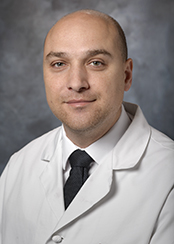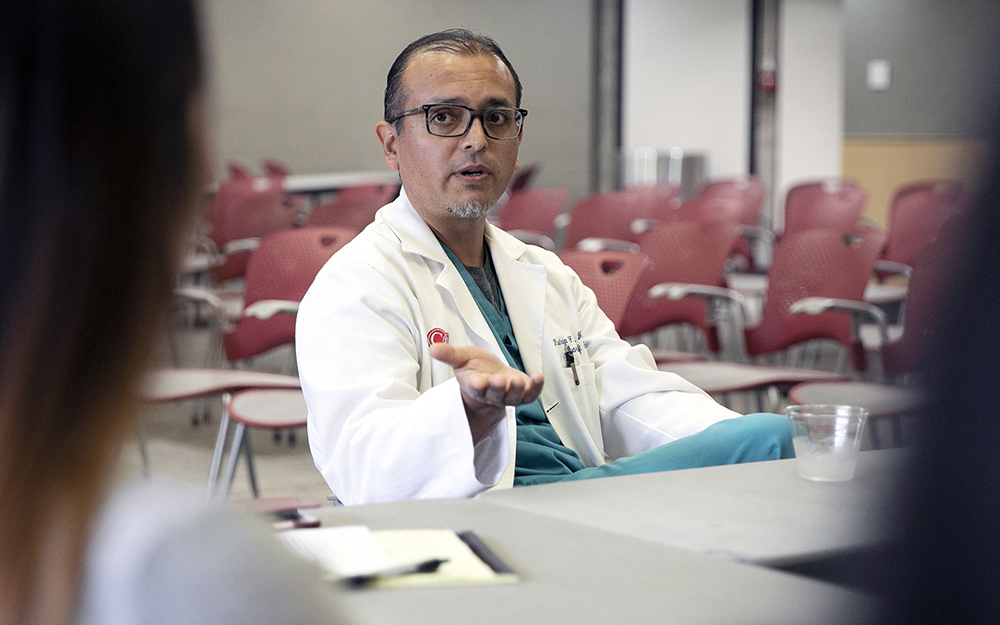Stop the Bleed Courses at Cedars-Sinai
Date
November 23, 2022

Date
November 23, 2022
Credits
Medical providers featured in this article

In Brief
{{cta-block}}
You may know how to step in and act when someone is choking or stops breathing. But do you know how to help a loved one or a stranger with traumatic bleeding?
These skills can save lives. A person can die of hemorrhaging in two to five minutes, outpacing the average emergency service response time of eight to 12 minutes, which may be significantly longer in rural areas.
Cedars-Sinai, a Level I trauma center, provides free, in-person Stop the Bleed® courses. The classes can prepare anyone to intervene in a bleeding emergency—whether at home or in public—until emergency medical professionals arrive.
"It’s like buying a fire extinguisher or prepping for an earthquake,” says Dr. Galinos Barmparas, associate trauma medical director at Cedars-Sinai. “The chances that you’re going to need to do this are small, but if you know how, you have a chance to help.”
Here, Dr. Barmparas and Gregory Jones, a registered nurse and trauma educator who teaches Stop the Bleed classes at Cedars-Sinai and in the community, outline the fundamentals of the course and explain why you should sign up.
{{providers}}
"It’s like buying a fire extinguisher or prepping for an earthquake. The chances that you’re going to need to do this are small, but if you know how, you have a chance to help."
Stop the Bleed is universally applicable
Stop the Bleed was developed by the American College of Surgeons following the 2012 school shooting at Sandy Hook Elementary School, but the principles and techniques apply to other, more common situations. Civilians might intervene in traumatic bleeding events related to car accidents, natural disasters, household knife accidents and even falls from trees.
"The vast majority of trauma injuries that cause people to bleed to death happen at home or on the freeway," Dr. Barmparas says.
Watch: Stop the Bleed demonstration
Simulated study for emergency preparedness
The first lesson in the hour-long course: In any emergency, keep yourself safe. Make sure you don’t become a casualty while you’re trying to help others. Exit crumbling buildings, get out of traffic danger and evade anyone with a weapon.
Once you’re safe, know how to recognize a life-threatening wound. Look for blood pooling on the ground and clothing soaked in blood, Jones says. Call 911 to summon responders to the scene.
When you locate the source, or sources, of the bleeding, if you don’t have bleeding control supplies, use a shirt to cover the wound, stack one hand on top of the other, and apply pressure until emergency providers arrive.
If you can locate gauze, pack the wound. Press the gauze tightly into a puncture or gash until you can’t fit any more, and then apply pressure until paramedics can help. This will be very painful for the injured person, but it is necessary to prevent massive, possibly life-threatening blood loss.
If a person’s limb is bleeding and you can locate a tourniquet, apply it 2-3 inches above the wound, but not on a joint. Only use a real tourniquet. Avoid improvising with a belt or a shoelace, which could cause further complications.
Jones teaches these skills with hands-on training using simulated wounds and real first-aid supplies. Practicing the mechanics can be significant in helping a person remember how to act quickly in a true emergency, he says.
Dr. Barmparas agrees that the course’s simplicity empowers people to believe they can help.
"Every person has a different mindset and response to stressful situations," he says. "By making this as simple as possible, we can assure people retain the information. First, make sure you’re safe. Then call 911, locate the bleeding, apply pressure and wait."
Get the supplies
Bleeding control kits that contain gauze, tourniquets and other supplies are commercially available, and they are installed in all airports and federal buildings in California. A new state law will require trauma bleeding control kits to be maintained in newly constructed public spaces in California—like some schools, gyms, businesses and apartment buildings.
A study by staff in Cedars-Sinai’s Division of Trauma and Critical Care found that 98% of Stop the Bleed course participants said they would be comfortable applying the principles they learned in real life. But a follow up questionnaire months later found that fewer than half of those surveyed had acquired gauze or a tourniquet.
The team says this indicates more awareness-building is needed to assure that bystanders know what to do in an emergency.
"You want to always maintain this knowledge but never have to use it," says Jones.





